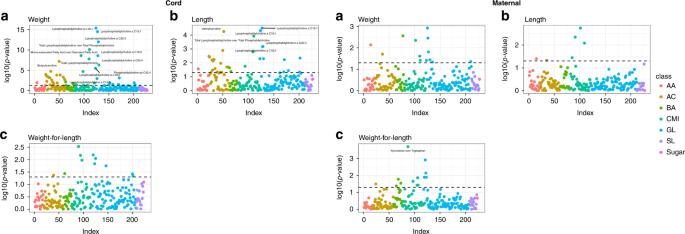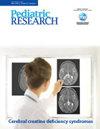母体血浆和脐带血浆代谢组学特征与出生时人体测量指标的关系
IF 3.1
3区 医学
Q1 PEDIATRICS
引用次数: 0
摘要
孕期母体血浆和出生时脐带血浆的代谢组学特征可能会影响胎儿的生长和出生时的人体测量。该研究旨在探讨母体血浆和脐带血浆代谢物与新生儿人体测量指标的关系,新生儿人体测量指标是预测未来健康状况的已知指标。一项前瞻性队列研究招募了妊娠 24-28 周的孕妇。使用 Biocrates AbsoluteIDQ® p180 试剂盒分析了 413 名入选孕妇的血液样本和 787 份婴儿脐带血样本。采用多变量线性回归模型研究了脐带血和母体代谢物与婴儿出生时人体测量的关系。在这个主要由白人居民组成的新罕布什尔州农村队列的脐带血样本中,13 种代谢物与出生体重 Z 值呈负相关,10 种代谢物与出生体重 Z 值呈正相关。酰基肉碱 C5 与出生身长 Z 值呈负相关,4 种溶血磷脂酰胆碱与出生身长 Z 值呈正相关。母体血液中的代谢物与出生体重和身长 Z 分数没有明显的相关性。在脐带血浆样本中,对能量利用起作用的几种酰基肉碱和一种参与氧化应激和炎症反应途径的溶血磷脂酰胆碱的研究结果一致。本文章由计算机程序翻译,如有差异,请以英文原文为准。

Associations of maternal plasma and umbilical cord plasma metabolomics profiles with birth anthropometric measures
The metabolomics profiles of maternal plasma during pregnancy and cord plasma at birth might influence fetal growth and birth anthropometry. The objective was to examine how maternal plasma and umbilical cord plasma metabolites are associated with newborn anthropometric measures, a known predictor of future health outcomes. Pregnant women between 24 and 28 weeks of gestation were recruited as part of a prospective cohort study. Blood samples from 413 women at enrollment and 787 infant cord blood samples were analyzed using the Biocrates AbsoluteIDQ® p180 kit. Multivariable linear regression models were used to examine associations of cord and maternal metabolites with infant anthropometry at birth. In cord blood samples from this rural cohort from New Hampshire of largely white residents, 13 metabolites showed negative associations, and 10 metabolites showed positive associations with birth weight Z-score. Acylcarnitine C5 showed negative association, and 4 lysophosphatidylcholines showed positive associations with birth length Z-score. Maternal blood metabolites did not significantly correlate with birth weight and length Z-scores. Consistent findings were observed for several acylcarnitines that play a role in utilization of energy sources, and a lysophosphatidylcholine that is part of oxidative stress and inflammatory response pathways in cord plasma samples.
求助全文
通过发布文献求助,成功后即可免费获取论文全文。
去求助
来源期刊

Pediatric Research
医学-小儿科
CiteScore
6.80
自引率
5.60%
发文量
473
审稿时长
3-8 weeks
期刊介绍:
Pediatric Research publishes original papers, invited reviews, and commentaries on the etiologies of children''s diseases and
disorders of development, extending from molecular biology to epidemiology. Use of model organisms and in vitro techniques
relevant to developmental biology and medicine are acceptable, as are translational human studies
 求助内容:
求助内容: 应助结果提醒方式:
应助结果提醒方式:


